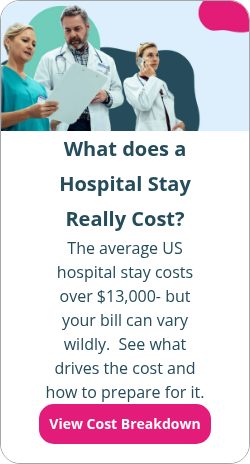Top 20 most expensive hospital procedures
By Elizabeth Walker on May 20, 2024 at 8:45 AM
Modern medicine allows patients to receive comprehensive, life-saving treatments every day. However, advancements in healthcare come with a cost. Without health insurance, a serious medical procedure in a hospital can cost more than the average U.S. annual household income, which was $74,580 in 20221.
Due to this high cost, individuals who require treatment often weigh the need for healthcare against a potentially high medical bill. KFF found that 61% of uninsured Americans went without much-needed medical care in the past 12 months due to the cost2.
In this article, we'll share the top 20 most expensive hospital procedures in the U.S., including the average costs without health insurance and how a health reimbursement arrangement (HRA) can help you cover your medical expenses.
Takeaways from this blog post:
- Hospital procedures can financially devastate patients, even with health insurance coverage. The price of a single procedure depends on the precision and expertise needed, medical equipment, administrative costs, and required post-operative and follow-up care.
- Currently, exploratory chest surgery, a pre-diagnostic surgery that physicians perform to better diagnose or treat an illness, is the most expensive hospital procedure, costing an average of $137,533.
- Employers can help employees manage their medical costs by offering a health reimbursement arrangement (HRA).
Top 20 most expensive hospital procedures
Generally, the more precision needed, the more a hospital procedure will cost. However, other factors can influence a total bill.
“The cost of procedures encompasses various factors, including medical equipment, personnel, facility fees, and post-operative care,” says Chris McDermott, a certified advanced practice registered nurse.
Medical procedures can be financially devastating for some patients, depending on the treatment they need. To give you a better idea, below are the top 20 most expensive hospital procedures in the U.S. with their average cost without health insurance3.
|
Rank |
Procedure |
What it involves |
Average hospital cost |
|
1 |
Exploratory chest surgery |
This expensive procedure is a pre-diagnostic surgery that physicians perform to better diagnose or treat an illness. |
$137,533 |
|
2 |
Aortic valve replacement |
This open heart surgery treats problems with the heart's aortic valve, which controls blood flow from the heart to the rest of the body. |
$135,984 |
|
3 |
Partial removal of the esophagus |
Physicians may need to remove part of the esophagus to reach large tumors. |
$113,756 |
|
4 |
Decompressive craniotomy |
This major surgery relieves pressure in the skull while maintaining a bone flap so brain tissue isn’t completely exposed. |
$112,984 |
|
5 |
Tracheostomy |
A tracheostomy involves creating an opening in the front of the neck so physicians can insert a breathing tube into the windpipe. |
$102,399 |
|
6 |
Liver transplant |
People need a liver transplant when their liver fails because of a disease or injury. |
$101,240 |
|
7 |
Aortic graft |
A graft is a synthetic tube inserted during surgery that repairs or replaces a diseased section of the aorta. |
$92,939 |
|
8 |
Transcatheter aortic valve replacement |
Known as TAVR, this surgery places a fully collapsible replacement valve in the heart with a catheter. |
$85,279 |
|
9 |
Tricuspid valve replacement |
This procedure replaces the tricuspid value, one of the two main values on the right side of the heart. |
$82,631 |
|
10 |
Tricuspid valve repair |
This procedure repairs the tricuspid valve. |
$82,431 |
|
11 |
Video EEG monitoring |
Video EEG monitoring helps doctors properly diagnose epilepsy from other illnesses. Doctors monitor brain waves with electrodes while video captures the patient's movements and behavior. |
$77,664 |
|
12 |
Carotid artery stent |
To treat blocked carotid arteries, physicians insert a mesh metal tube, or stent, into the artery so blood can safely flow to the brain. |
$77,529 |
|
13 |
Coronary artery bypass graft |
This surgery improves circulation by rerouting blood around a blocked or narrowed coronary artery. |
$77,177 |
|
14 |
Lumbar spine surgery |
This invasive procedure is a surgery on the lower section of the spine. |
$75,361 |
|
15 |
Mitral valve repair |
This surgery repairs the mitral valve, a valve on the left side of the heart. |
$74,144 |
|
16 |
Laminectomy |
During a laminectomy, physicians remove the rear section of bone from one or more vertebrae. |
$73,363 |
|
17 |
Mitral valve replacement |
This procedure replaces the mitral valve. |
$73,154 |
|
18 |
Breast reconstruction surgery |
Breast reconstruction surgery recreates the breasts after mastectomy or lumpectomy. Reconstruction can involve several expensive surgeries. |
$73,100 |
|
19 |
Small intestine repair |
This complex procedure repairs the damaged or diseased portion of the small intestine. |
$72,757 |
|
20 |
Vascular bypass graft |
Like a coronary artery graft, a vascular bypass graft redirects blood around damaged or narrow arteries using healthy blood vessels. |
$70,846 |
How health insurance can help you pay for medical care
Your first step toward reducing your medical bills is by securing health insurance. Health insurance helps you pay for the services and items that your plan covers, like doctor visits, hospital procedures, preventative care, prescription drugs, annual screenings, and more.
Your employer can offer you health insurance—typically in the form of group health insurance—or you can enroll in an individual health policy. If you meet the age or income requirements, you may also be eligible for a federal health insurance program, like Medicare or Medicaid.
If you don’t have employer-sponsored health insurance, there are several different ways to get health insurance. You can enroll in an individual health plan on a public exchange, like the federal Health Insurance Marketplace or a state-based marketplace. You can also shop for a policy on a private exchange—such as through a broker or insurance company directly—for a more personalized experience.
Unless you have a qualifying life event triggering a special enrollment period, you can enroll in a health plan during the annual open enrollment period. Typically, on health exchanges, you’ll have access to a customer service team that can help you shop, compare, and enroll in a policy.
Having health insurance has many advantages. In an emergency (or for routine care), you’ll have the coverage you need to help you pay for your medical bills. Additionally, if you have a surprise medical bill, you can work with your health insurer to negotiate your bills and potentially reduce the cost.
How an HRA can help you cover your medical bills
Hospital procedures can be financially draining, especially if you need major surgery or various forms of treatment. Even with health insurance coverage, you may still experience a hefty hospital bill due to deductibles and coinsurance. That’s why it’s important to have access to financial help.
“Addressing not only the clinical but also the economic aspects of surgical care is crucial for a holistic approach to patient healthcare management,” says Dr. Kristopher M. Day, a plastic and reconstructive surgeon in Washington.
One way you can better control your healthcare costs is by suggesting your employer add an HRA to your benefits package. An HRA is a customizable benefit employers offer employees to help them manage their medical costs. With this health benefit, your employer can reimburse you tax-free for qualified out-of-pocket costs. Depending on the type of HRA, you can even receive reimbursements on your health insurance premiums.
Unlike a health savings account (HSA), which allows you to contribute to an account for future medical expenses, your employer owns the HRA, and only they can fund it. They’ll give you a monthly allowance to spend on healthcare. Once you incur an eligible expense, they’ll reimburse you up to your set allowance amount. Allowance amounts roll over monthly, but HRA funds stay with your employer if you leave their company.
Below, we’ll explain in more detail how three popular types of HRAs can save you money on medical procedure costs.
Qualified small employer HRA
A qualified small employer HRA (QSEHRA) is an excellent option if your employer has fewer than 50 full-time equivalent employees (FTEs). Full-time W-2 employees are automatically eligible to participate, but your employer can also offer the benefit to part-time employees. In either case, you must have a health insurance policy with minimum essential coverage (MEC) to participate in the QSEHRA.
With a QSEHRA, you choose the individual coverage and healthcare providers that best meet your medical needs. Your individual plan premiums and out-of-pocket expenses are eligible for reimbursement. However, your employer can limit reimbursements to only health insurance premiums. Qualified out-of-pocket expenses include prescription drugs, non-cosmetic surgeries, ambulance services, hospital fees, medical diagnostic services, and more.
QSEHRAs have maximum contribution limits that the IRS sets annually. Once you reach your allowance limit, you can’t exceed it. If you run out of allowance for a given month, you’ll have to wait until the following month to receive more money.
Lastly, if you qualify for premium tax credits, your eligibility to collect them depends on whether your benefit is affordable. If your QSEHRA is affordable for a given month, you can’t collect your tax credits for that month. If your benefit isn’t affordable for one or more months, you can still collect your credits, but you must reduce your credits by the amount of your allowance.
Individual coverage HRA
Another option for your employer is the individual coverage HRA (ICHRA). It works similarly to the QSEHRA but is for businesses of all sizes and has no maximum contribution limits. It also allows your employer to offer different allowance amounts to different classes of employees, such as full-time or part-time.
Like the QSEHRA, your employer can reimburse you for individual health plan premiums and qualified out-of-pocket medical expenses. However, only employees with an individual health policy can participate. This means you can’t participate if you have coverage from your spouse’s group health plan.
If you want to collect premium tax credits, you can opt in or opt out of an ICHRA based on affordability. You must choose between the ICHRA and your premium tax credits—you can’t have both. If your ICHRA is affordable, you should waive your credits and opt into the benefit. But if it's not affordable, you can opt out of the ICHRA and receive your credits.
Group coverage HRA
If your employer is already offering you traditional group health insurance, you can ask if they will supplement it with a group coverage HRA (GCHRA). Also called an integrated HRA, this benefit reimburses employees tax-free for out-of-pocket medical expenses the group policy doesn’t fully cover, like deductibles, coinsurance, copayments, and more.
To participate in a GCHRA, you must enroll in your employer’s group health coverage. However, you can’t receive reimbursements for premiums. This is because most employer-sponsored health plans use pre-tax deductions to pay for premiums; therefore, the IRS considers receiving tax-free HRA reimbursements for them as “double-dipping.”
With a GCHRA, you can have the familiarity of a traditional group health plan and an alternative health benefit that can help you pay for medical care expenses, like hospital stays. This means you pay less out of pocket and can make informed decisions regarding your health.
Conclusion
Medical procedures in the U.S. can be expensive, especially if you have a chronic disease or need multiple surgeries. Even if you must receive one of the procedures included in the list above, it's essential to research your available options and potential hospital costs so you can make the best financial decision for you and your family.
If your employer offers you an HRA, you can leverage it to reduce the financial burden of your out-of-pocket medical expenses, such as deductibles and copays for costly hospital procedures. With an HRA, you can choose the health insurance plan with the best coverage for your personal needs, giving you more freedom over your healthcare.
This article was originally published on November 4, 2013. It was last updated on May 20, 2024.
1. https://www.census.gov/library/publications/2023/demo/p60-279.html
2. https://www.kff.org/health-costs/issue-brief/americans-challenges-with-health-care-costs/
3. https://arcadia.io/resources/the-most-expensive-medical-procedures-in-the-u-s
Check out more resources
See these related articles

What can an HRA reimburse?
Wondering if your HRA can cover specific medical costs? Discover the comprehensive list of eligible expenses that your HRA can reimburse in this article.

What is a health insurance subsidy?
Discover the ins and outs of health insurance subsidies with this comprehensive overview. Learn how they can help make healthcare more affordable for you.

What does out-of-pocket medical expense mean?
Learn what 'out-of-pocket' medical expenses mean and how they impact your healthcare costs. Understand deductibles, copayments, and more.



